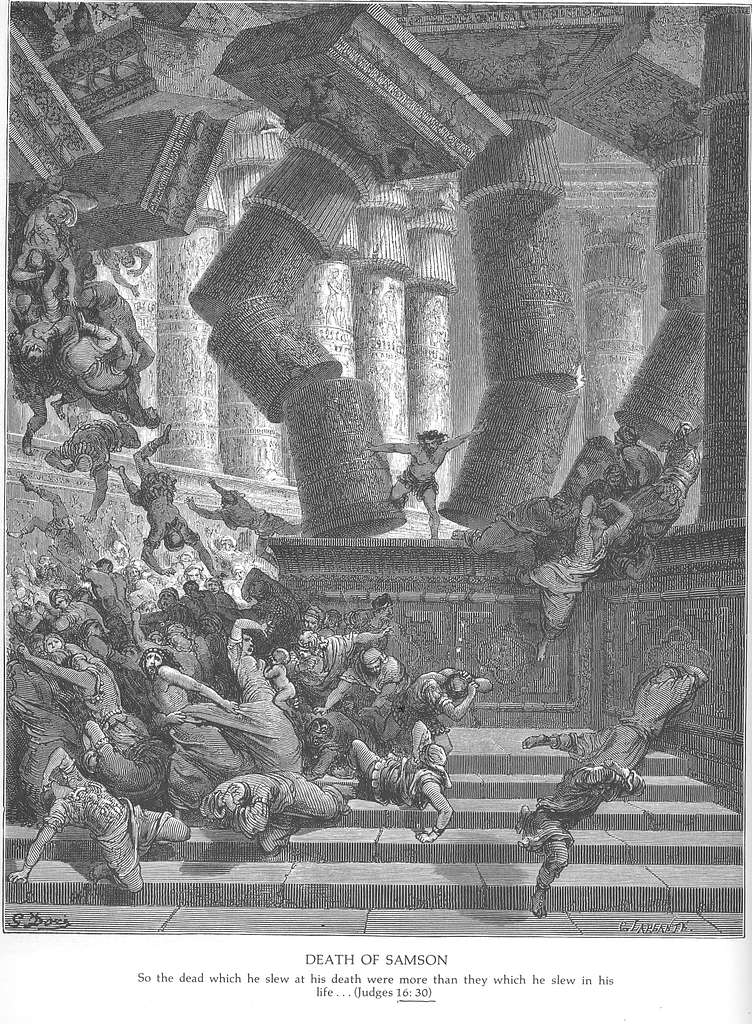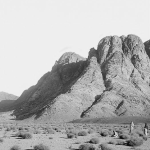
It’s one of the most famous stories of the Old Testament. Strong man Samson, who was a leader in Israel for twenty years, lived in the first half of the 11th century B.C. He was a captive of the Philistines right before he died, and the Bible describes his famous death as follows:
Judges 16:29-30 (RSV) Samson grasped the two middle pillars upon which the house rested, and he leaned his weight upon them, his right hand on the one and his left hand on the other. [30] . . . Then he bowed with all his might; and the house fell upon the lords and upon all the people that were in it. . . .
Is this merely an intended myth of a folk-hero, meant to provide entertainment around a campfire with a skilled storyteller? Or was it intended to record a real historical event? Perhaps surprisingly to many, archaeological evidence indicates that the latter is the case. Samson’s death occurred in Gaza, as we know from Judges 16:1. It hasn’t been excavated because the current city sits on top of the town from the time of the Judges Thus our task is to determine if other temples in the area – that still exist in ruins or archaeological sites — had these two central pillars. What Samson destroyed was a temple dedicated to Dagon (Jud 16:23 ff.).
Four Philistine buildings of this sort have indeed been discovered: all having stone bases about 6-7 feet apart, along the central axis, upon which wooden pillars once stood, holding up the entire house, exactly as the Bible describes. Two were in ancient Ekron, about 40 miles from Gaza. These were discovered between 1981 and 1996 and dated to the 11th and 12th centuries BC: before or during Samson’s lifetime. A third was located in 2010 in Gath, the hometown of the most famous Philistine: Goliath, some 19-22 miles away, with what was described as “two pillars in the center of the structure”. This temple was dated to the 9th century B.C., so it’s later than Samson, but it’s additional corroborating evidence of Philistine buildings with two central pillars.
The fourth was located in a northern suburb of Tel Aviv, within about 44 miles; found in 1972 and also dated to the 11th-12th century BC. Archaeologists Avraham Negev and Shimon Gibson state that “The roof was supported by two cedar wood columns . . . on cylindrical stone bases running along the long axis of the hall.” Note that we’re talking about cedar columns of about one foot in diameter, resting on stone bases, rather than a completely stone pillar. Samson merely had to disconnect them from their foundation stones. In the temple near Tel Aviv, the cedar posts were held in place only by the weight of the roof, and were about six to six and-a-half feet apart. The pillars at the Ekron temple are about seven and-a-half feet apart. Since they vary in distance, it’s quite possible that the pillars in the building in Gaza where Samson died could have been closer to one another.
A tall man — especially if he has very long arms, as many basketball players do –, can reach these distances. An article about NBA players with the longest “wingspans” noted that Wilt Chamberlain’s and Dwight Howard’s spans were seven foot eight inches, and that Shaquille O’Neal’s was seven foot seven inches. Two current players can reach seven foot ten inches. All of these could easily reach the two pillars near Tel Aviv, and even the one at Ekron. The Bible doesn’t indicate how tall Samson was, but the point is that there are people today who can demonstrably reach this far; therefore, it’s possible that Samson could also have done so. It’s not mere myth or a fairy tale, where impossibilities and fantastic exaggerations prevail.
One might still wonder, however, if a man could have the strength to topple these pillars? According to the Guinness Book of World Records, Canadian Gregg Ernst has lifted 5340 pounds, or two tons and two-thirds. Is it possible, then, to do what Samson is reported to have done? It seems so, because it’s not impossible that he was as strong or stronger than Gregg Ernst, since he is described three times in the book of Judges as possessing “great strength” (16:5-6, 15). He also prayed to God right before he died, to “strengthen” him (Jud 16:28), so for those who believe in such things, he also had at least some extra supernatural strength from God as well. The fact that the one-foot wide Philistine cedar pillars were at least sometimes not connected to their stone bases makes what he is reported to have done possibly much easier to do, too.
This is but one of scores and scores of instances where archaeology backs up and verifies the historicity of a biblical account. It’s not proof that the Bible is divinely inspired, but on the other hand, an inspired book deriving ultimately from God would indeed have the quality of being uncannily accurate; precisely because God is guiding it. And we observe that sort of accuracy and true-to-history character in this biblical account of Samson.
My Related Articles
Samson’s Death-Scene: Archaeological Confirmation (3-27-23)
Other Related Articles and Books
Bryan Windle, “Top Ten Discoveries Related to the Book of Judges,” Bible Archaeology Report, 6-10-22.
“TEL MlQNE-EKRON: Summary of Fourteen Seasons of Excavation 1981-1996” (The W.F. Albright Institute of Archaeological Research and The lnstitute of Archaeology, Hebrew University of Jerusalem, 2005.
Avraham Negev and Shimon Gibson, Archaeological Encyclopedia of the Holy Land, New York: Continuum, revised and updated edition, 2003, “Qasile (a) (TELL)”: 414-416.
Ben Hartman, “Temple found in Philistine home of Goliath” (The Jerusalem Post, 7-29-10).
My Related Books
The Word Set in Stone: How Archaeology, Science, and History Back Up the Bible (Catholic Answers Press: March 15, 2023, 271 pages).
My Related Web Page
Jews, Judaism, and the Old Testament












